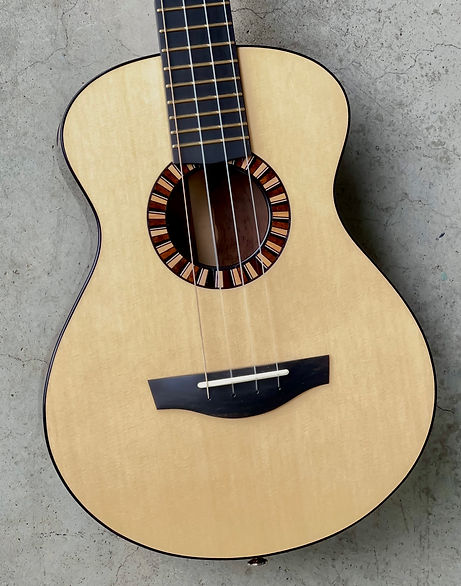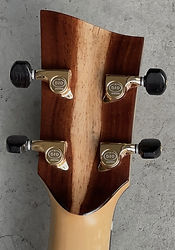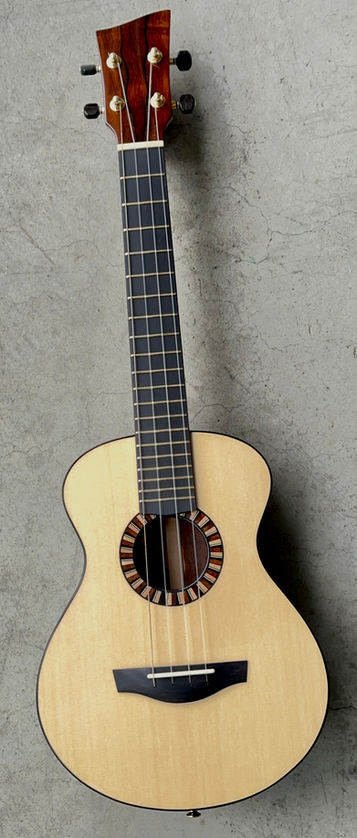Waterfall Brazilian

There's nothing like Brazilian rosewood. It's intimate. It's sensitive. And at times strikingly beautiful. This set is all of that. The beauty of the tone is sublime. You're enveloped. The decay of the sustain lingers. It draws you in and the aroma is intoxicating. Nothing smells like Brazilian. You just want to cradle the ukulele in your arms with the hope that it will take your music where it hasn't been before. It could happen.
So it took me a while to give this tenor up. I finished it at the end of 2024 but it's essentially brand new. I can't keep all my favorites. The Brazilian is pre-cities and I don't have any documentation for it so it will have to stay in the US. I have more old sets but this one is the most dramatic.
Some would call the figure "waterfall" because of the large wide curls. Seems appropriate. For a long time I was intimidated by its beauty and expense and reluctant to build with it. But after decades of building I'm confident that I have done this wood justice. Surprisingly, it was quite easy to work with.
I finished it with a thin glossy catalyzed urethane lacquer to enhance its beauty. I didn't use a different material to pore fill the wood. I wanted to get the most out of the Brazilian rosewood tone. A lot of the pores are filled with the finish anyway.
The back braces are carved Adirondack spruce with parabolic cross sections. Braces are tapered at the ends and let-in to the linings. The linings are solid maple, laminated and carved in place. They make the sides more rigid which helps the top and back work together to produce a complex tonal response. Linings are let-in to the heel and tail blocks.





The top is a very fine-grained Alaskan yellow cedar. It's stiff with an immediate response. The tone is clear yet warm which compliments the rosewood. There is wonderful note to note separation. Lush overtones don't interfere with the fundamentals. This tenor sings. It's a fingerstyle playground enhanced by a scalloped X-bracing design where every cedar and Adirondack spruce brace has a size and shape for its intended purpose. The top is continually voiced throughout the brace shaping for the best result. This tenor is designed for enough headroom to be driven without faltering but it excels with a thoughtful attack. The top is protected with a thin clear pickguard.
There isn't much adornment in the overall design. Why gild the lily? No abalone or fancy purfling to detract from the gorgeous Brazilian rosewood. But I did include a rather sedate rosette of side grained Brazilian rosewood, ebony and silver birch at the soundhole. There is ebony binding with a single birch purfling line on the sides. The reinforced oval sound port has a purfling line as well.
In addition to the top, the neck is also Alaskan yellow cedar with Brazilian rosewood head and back plates. A brass bolt through the Gotoh strap button is anchored with a threaded insert in the body's heel block. There is also a bolt on the inside of the body with an insert in the neck heel. The fingerboard extension is minimally glued down for a solid yet easily removable joint in case of instrument damage. A Gotoh strap button is also at the tail.
The bound fingerboard and string through bridge are unadorned ebony with brass and aluminum position markers on the side. Frets are Stew-Mac gold alloy with polished and rounded ends. There is a 16-20 inch radius for making bar cords easier. The intonated saddle and 1 1/2 inch nut are unbleached bone. The strings are PHDs with a Pepe Romero smooth wound low G.
This Ken Franklin tenor comes with a basic protective wooden case. Demo Sold

